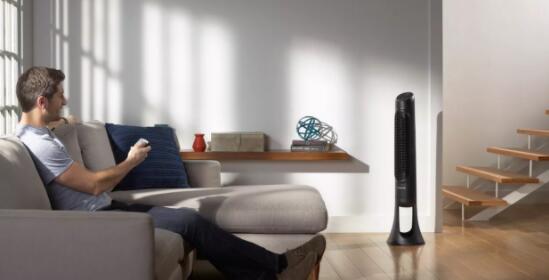Most homeowners love oscillating fans, especially during the summer seasons. Furthermore, the oscillating fans have the potential of swiveling forth and back; it guarantees you air circulation hence cooling your entire house during hot temperatures. However, when they function for a long time, they are likely to produce rattling or buzzing noises.
When this happens to you, do not hurry to purchase a new oscillating tower fan since most of these fans can be repaired even if you lack a mechanic background.
If you are worried about how you can make you oscillating tower fan quiet, worry less because this article will make you informed.
What Are the Best Quiet Oscillating Tower Fans Recommended on the Market?
How to Make an Oscillating Tower Fan Quiet?
Therefore, below are some tips that can help you to make an oscillating tower fan quiet. These are:

Maintain your fan on a leveled surface
Your fan might be generating noise because the fan base is hitting the uneven floor. Therefore, it is appropriate that you make sure you position your fan on a leveled and smooth surface to distribute your fan’s weight evenly. In case you do not place it on a leveled surface, your fan’s whole weight is likely to shift with it, making the whole system produce noise.
Place your fan on a carpet or rug
After placing your fan on a leveled surface but you can still experience rattles as well as imbalances. This signifies that your fan base is either warped or even damaged; note that this can also cause the whole system shift when the blades of your fan spin. In case this happens to you, it is appropriate that you position a heavy sound dampening carpet or rug, instead of opting to have a base replacement. Note that as the entire of your fan shifts, the carpet and rug will cushion it, hence muting any unwanted sound.
Clean it regularly and thoroughly
Make a point of cleaning your fan unit once every month to avoid dust accumulation, which might harm moving parts of your fan. If you fail to clean it regularly and thoroughly, it might generate a lot of noise. With sufficient care, open the fan’s part, achieve this successfully, ensure that you switch off your fan, and unplug it from the power source. Moreover, commence by unlatching the blade guard in front and get it out. After that, unscrew the fan’s cap in the middle of your blades. When you do this correctly, the blade will slide correctly. Confiscate the fan’s second cap, splitting blades from the cage’s back. When you are through, carefully slide off the cage back, which will leave you with a bare motor. Using a dry cloth, clean blades, caps, and the cage by eliminating dust. After that, make sure that you wash it with a soapy damp cloth.
When you are through with this, wipe it dry. When it comes to the motor, wipe its exterior using a dry cloth and spray the canned air into your motor to ensure that you clean the parts you cannot contact with a dry cloth. Ideally, make sure that the fundamental components are dust-free and dry completely before you go ahead to reassemble your fan.
Tighten loose knobs and screws
After reassembling your fan, you might also want to examine your motor exterior for loose knobs and screws. In case you get, use a wrench or screwdriver to tighten them; this will prevent them from dislodging or shaking when you switch on your fan. Furthermore, you should not disassemble or open your motor; it would be appropriate to examine loose parts outside.
Align the fan blades
When your fan is apart, it is appropriate that you also examine the fan blades alignment. Your fan might be imbalanced due to uneven blades, causing your fan to generate a whirring sound whenever you switch it on. To fix this problem, check the fan’s blade by positioning them flat on a leveled surface. Examine if the entire buttons of your blade are reaching the under the surface.
After that, examine the top side by positioning a level piece of plastic sheet, hard cardboard, or flat over your blades and check if the entire top blades are touching the above surface. On the other hand, several fans come with metal blades. In this case, it is perfect if you bend your blades gently and carefully until you ensure that they are all aligned. Moreover, other fans come with plastic blades, positioned on the metal center. With this kind of metal, you can easily adjust your mounting metal center. In case your blades have a complete make of plastic, it means you will have to replace your entre blades.
Oil your fan motor
It is appropriate that you oil the inside of your motor. This will enable the fan’s internal mechanism to glide smoothly without any clunking or clicking noises. You can opt to use a non-detergent oil or SAE 20, but do not use beyond two drops at a go since you are likely to damage your fans motor. Note that you should do this carefully, at least thrice or twice annually.
Change the damaged cushioning
Several rotating fans come with foam cushioning between the caps sandwiching your fan blades. These cushioning prevent the fan from generating noise hence maintaining quietness. Furthermore, when cushions are worn out, scratched, or damaged, they are likely to produce some noise with time. Note that you cannot repair damaged cushions once they incur some damages. This means you have to remove them and replace them with new ones, supposedly purchased from the nearest hardware store. Use glue adhesive or rubber to position it where you had removed the previous cushioning. When you are through, allow it to dry before you think of reassembling your fan completely.

Hack your fan cage
In case the noise you fan is producing is not from blades, motor, or base, this noise is likely to be coming from the cage or blade guards. Additionally, the cage is from metals and has clasps on its side made of plastic or metal. Note that these parts can break or warp with time hence generating noise. You can fix this problem yourself; if you find warped edges, wedge a heavy piece of rubber or cardboard between to ensure you have closed the gap with a small diameter to prevent the blades from hitting when they commence spinning. On the other hand, the cage comes with a decorative cap on your fan exterior front center and can be loose anytime; you can fix this using permanent glue.
Conclusion
Based on the above information, you are now familiar with making an oscillating tower fan quiet. Therefore, it is upon you to ensure that you always implement the above tips to ensure that your fan is quiet whenever it will be functioning. I hope you will benefit from this article to know how to make an oscillating tower fan quiet.









